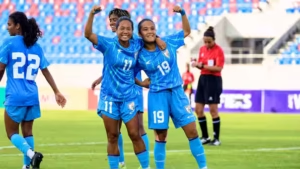In a bid to correct a longstanding flaw in its developmental pipeline, the All India Football Federation (AIFF) is undertaking a strategic overhaul of the India U23 Men’s National Team setup.
With a focus on long-term player growth, consistent international exposure, and better results in key competitions, the AIFF has shortlisted 29 players for a preparatory camp ahead of friendlies in June 2025, followed by major international tournaments later this year.
This marks a significant shift from the reactive and sporadic approach of previous years — one that left many talented players underprepared and underexposed.
From U-16 Promise to U-23 Plateau
India’s journey in youth football has shown glimpses of promise, particularly at the U-16 level. Under the guidance of Bibiano Fernandes, the U-16 side qualified for the AFC U-17 Championship three times since 2016, and even reached the quarter-finals in 2018.
These were signs of a promising generation — technically sound, tactically aware, and unafraid of big stages.
But that momentum hasn’t translated well at the U-20 or U-23 levels. There has been a noticeable drop-off in performance and exposure once players graduate beyond the U-16 system. A major reason is structural: while countries across Asia use every FIFA international window to give their youth teams match time, India’s U-20 and U-23 sides have rarely played outside of tournament qualifiers.
This lack of regular camps, friendlies, and continuity has meant that India’s young talent often steps into major competitions with minimal preparation — a disadvantage too large to ignore.
A Difficult Track Record at the U-23 Level
The numbers speak volumes about the challenges at this level. Since 2014, India’s U-23 team has managed just 7 wins in 18 AFC U-23 Asian Cup qualifiers — a tournament that also serves as the qualifier for the Olympic Games. India has never come close to making it to the final tournament, let alone contending for a spot at the Olympics.

The Asian Games record isn’t much better. Since 2002, the U-23 side has suffered 9 losses in 16 games, with limited success against higher-ranked opponents.
In 2018, the team didn’t even participate due to differences between the AIFF and the Indian Olympic Association (IOA). In 2022, the U-23 side was only sent after a last-minute intervention by AIFF President Kalyan Chaubey.
New Coach, New Vision
Now, there’s an effort to change that narrative.
Naushad Moosa, assistant coach at NorthEast United FC, has been handed the reins of the U-23 national team. Moosa is not new to youth football — having worked extensively at Bengaluru FC’s youth and reserve teams before his ISL coaching roles. In March 2025, he led the Indian U-23s against Malaysia, and his second assignment will begin this June.
As part of their revamped schedule, India U-23 will travel to Dushanbe, where they are slated to play Tajikistan and Kyrgyzstan in friendly matches on June 18 and 21, 2025. These matches are being viewed as key tune-ups ahead of the AFC U-23 Asian Cup Qualifiers, which will take place from September 1–9, 2025.
Building a Cohesive Core
The 29 players selected for the preparatory camp reflect a diverse mix of ISL reserves, I-League standouts, and AIFF-identified prospects. The goal is not just to compete in September, but to build a consistent U-23 core that can graduate to the senior team in future years.
Importantly, the AIFF has committed to utilizing all possible FIFA windows, allowing the U-23s to play regularly and build chemistry — a crucial element missing in previous cycles. This decision comes in line with global best practices, where continuity at the youth level often translates into senior national team stability.
For India, consistent U-23 development is more than just about tournament results. It’s about creating a dependable bridge between junior and senior levels, ensuring that players don’t stagnate between youth promise and senior success.
The current batch of U-23s has an opportunity — and responsibility — to set the tone for future age-group cycles. With a clearer pathway, more matches, and a capable coach in charge, the Indian U-23 Men’s National Team finally seems to be on the path to relevance and results.
This June will offer the first test of this new approach. But for now, there’s one message from the AIFF — this is not a temporary fix, but the beginning of a sustained project to lift India’s footballing standards, one age group at a time.
Inputs from Khelnow Website
How useful was this post?
Click on a star to rate it!
Average rating 0 / 5. Vote count: 0
No votes so far! Be the first to rate this post.






